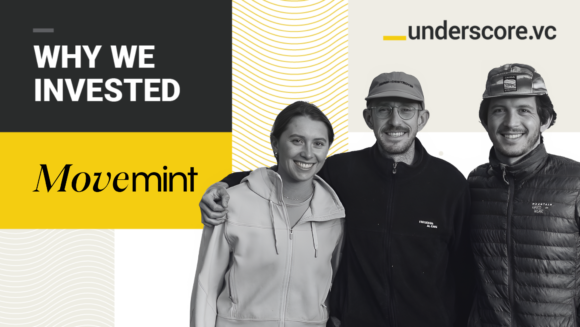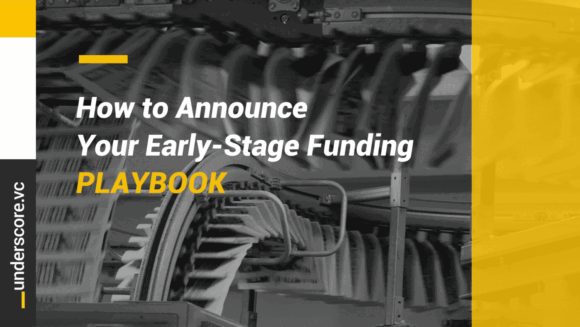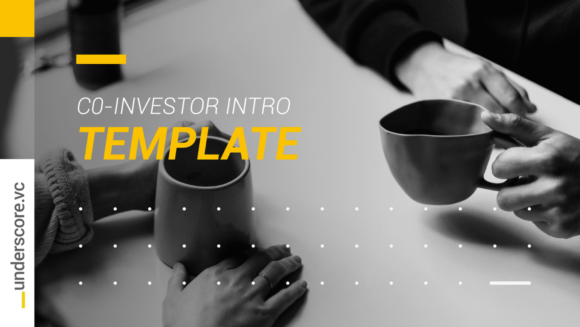How much traction do I need to raise a Seed funding round? What counts as traction? Should I be raising a Seed or Pre-Seed?
To all these questions and more, the answer from many early-stage VCs is: It depends.
But for most founders, this answer is completely unhelpful.
Our goal in publishing this piece is to help demystify what “it depends” on, so you can identify your strengths and weaknesses and determine if you have “enough” traction.
In this video, Underscore VC investor Brian Devaney shares what investors are looking for at Seed.
We’ll start with a holistic review of milestones and Seed funding.
What is a “Seed” round these days?
“Defining a ‘Seed’ investment is tough because each venture capital fund has slightly different stage definitions,” says Brian. From Underscore’s perspective, a Pre-Seed round is likely under $1M, while a Seed round could be between $1-4M.
But what matters more than round labels is that you’re able to raise the capital needed to get you to the next chapter of your startup journey.
“Instead of round labels, it can be easier to think about flavors of maturity,” says Underscore investor Sooah Cho.
- Founder with an idea + pitch deck
- Founder with an idea + pitch deck + MVP
- Founder with a pitch deck + vision + MVP + customers
- Founder with a pitch deck + vision + MVP + paying customers
A Few Notes on Pre-Seed Rounds
“There’s a big risk inflection point, at least in the eyes of investors, going from pre-product and pre-revenue to having a product shipped and proof that people love it,” says Brian.
If your startup is pre-product, think through the amount of funds it would take to cross that inflection point, and consider raising a smaller Pre-Seed round to cover it. “Even if you can jump to raising a $2M-$3M Seed round, you may be taking unnecessary dilution,” Brian adds.
How We Define Seed Funding Milestones
Typically, we think of milestones in terms of founding team, product development, market, and traction. They’re often framed as:
- What hypotheses do you have about your business?
- What will it take for you to find an answer and set you on a path to tackle your next milestone?
Even with the chaotic market dynamics of 2022, these milestones still hold true.
Founding Team: Do you have founder-market fit?
Above all, potential early-stage investors are typically looking for exceptional people. “That’s why we start with founder-market fit: being uniquely qualified to tackle the problem you’re solving,” says Sooah.
This typically involves:
Lived experience: You understand the problem because you’ve experienced it first-hand. Having felt the pain, you know why it matters, how important it is, and what it will take to solve it.
Unique market insight: You “know more about an industry than an investor does,” says Brian. And you can articulate a very nuanced and unique perspective on what it will take to solve the problem.
That means you’ve got detailed information on how the industry works, and you know the space like the back of your hand. That includes:
- Who else is in the market?
- Who’s done this before?
- Why has it worked or not worked in the past?
- Why is your approach going to work now?
- What hypotheses are you testing and proving?
- What next steps will you need to take to continue learning?
For example, while digging into a recent investment opportunity, Brian emailed a founder a question: “Hey, we’re interested to hear how you think about your positioning versus these other two companies.” This founder responded immediately.
“In the amount of time that it would have taken to simply write the email, he shared a crisp, clear answer filled with rich insights and deep thought,” says Brian. “He didn’t need to do any research; the knowledge was already in his head.”
“This level of insight gives a founder a big advantage when it comes to navigating the market, relative to competitors and new entrants who have to learn the market ‘from scratch’ as they build.”
Problem obsession: You are obsessed with the problem and genuinely enjoy working on it. “When I meet founders who’ve experienced the problem first-hand, they learn and execute with such urgency to solve the pain point for others,” says Sooah. “Plus, you can tell they’ll genuinely have a blast working on it—and that gets them through even the toughest of times.”
Startup operating DNA: You have the startup operating DNA needed to build a venture scale tech company. “They can handle the ambiguity of building everything from scratch, test things, fail fast, and chart a path forward,” says Brian.
Beyond an individual founder, Seed funding rounds typically have a more complete team across product and GTM. What makes them uniquely qualified to own their function of the business?
Product Development: Do you have a product in customers’ hands?
“Ideally, you’ve built an MVP and have it in the hands of paying customers, demonstrating potential demand and willingness to pay,” says Sooah. Plus, you have ideas for how you will further capture customer dollars.
A great product can SLIP into the market:
- Simple to install and use
- Low initial cost
- Immediate and ongoing value
- Plays well in the ecosystem
Market: Can you prove a massive market opportunity?
Much of this comes down to customer knowledge. You’ve talked to hundreds of potential customers, gathered endless customer notes and quotes, and can show why you have such conviction in the opportunity. “If you can condense this information into a pitch narrative before synthesizing the key insights in a pitch deck, that’s extremely powerful,” says Sooah.
How can you convincingly describe the opportunity? Try outlining it as a before and after story:
- Here’s how the work gets done today (via a distillation of all the customer conversations you’ve had).
- Here’s how it would be done after the product is delivered.
- Here’s why it’s going to be so much better.
Investors will validate this story in their due diligence. “In a perfect world, the target audience will express the same challenge in the ‘before’ and have the same positive reaction to the idea and its ‘after,’” says Brian.
“If I speak with someone who’s never heard of the product, and they’re so excited about it that they want to be introduced to the founder, that’s a great sign,” says Brian.
Traction: Do you have early signs of repeatability?
Ideally, you’ve got some early signs of organic traction. This could include customers pre-paying for the product or showing early signs of go-to-market efficiency.
When you’ve got usage, proof of low churn, leading indicators, or early revenue traction, your Seed investment opportunity is more powerful.
What Changed for Seed Funding in 2022
To state it clearly: “Traction is one of the biggest differences,” says Brian. “In this current market, we’re looking for raving traction—not apathetic traction.”
But in addition to these benchmarks, many Seed investors also look at speed of both execution and learning.
Speed of Learning
At the Seed stage, you typically think there is a huge opportunity, but you may not know exactly how to solve it. Proving that people will pay for your solution requires fast experimentation and learning to show that you are moving in the right direction.
How do you show this? By sharing very specific and well-articulated hypotheses. And then in between each touch point with an investor, crisply articulate what worked or didn’t work—and why.
Speed of Execution
“Can you ship fast, build a minimum viable product, and get it in the hands of users?” asks Brian. After all, if you can do something in three months instead of six, you’ve just saved three months of burn. This all leads to capital efficiency.
“Capital efficiency is something that VC firms are going to look for in startups to navigate, survive, and even thrive in this market environment,” says Sooah. “You need to be able to get farther with less resources given the cost of capital now.”
What This Means for You in 2023
So, given all of the above… how much initial traction do you need to raise a Seed funding round? Let’s consider a few different scenarios.
Say a founder has worked at a massive freight company, knows everything about supply chain logistics, and has really unique insights into the market—but it’s her first time building a startup. Throughout her fundraise, she’ll need to show speed of learning and execution to prove she can get things moving from zero to one.
Or say there’s an experienced startup founder with a previous strong exit, but he’s still learning about a market. He’ll need to double down on deep proof points and testimonials from prospective customers to validate the problem.
Or there could be a young entrepreneur with limited work experience, but with a great idea and tons of ambition. Before raising Seed money, she’ll need to show she can learn incredibly fast, has developed a “mastery of customer pain,” and that she has strong initial traction, says Brian.
Reflect on the above-mentioned characteristics. The more you’ve got, the more flexible the traction bar may be. The fewer you have, the more leading indicators, user engagement, or revenue you may need to get your business over the line. Where do you fall?














